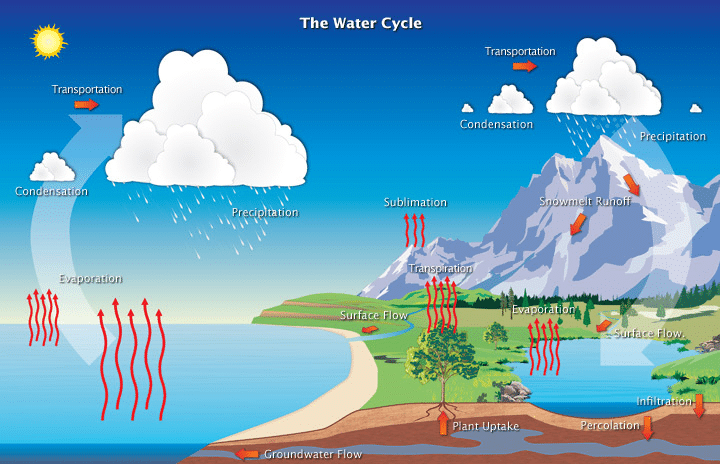The hydrological cycle, or water cycle, is Earth's process of recycling water. It describes the continuous movement of water between the Earth's surface and the atmosphere through processes like evaporation, transpiration, condensation, precipitation, and runoff. This cycle maintains water balance, regulates distribution, and supports ecosystems, agriculture, and human needs.
Human activities, such as water pollution, over-extraction, deforestation, and climate change, disrupt this cycle, threatening water quality, availability, and natural flow. Thus, protecting natural water storage systems like oceans, glaciers, groundwater, and lakes is essential for sustaining water resources and maintaining the balance of the hydrological cycle.
Hydrological Cycle Definition
The hydrological cycle often called the water cycle, is Earth's natural process of recycling water. It describes the continuous movement of water between the Earth's surface and the atmosphere, from the ground up into the atmosphere and then returning to the ground.
Hydrological Cycle Components
The hydrological cycle involves various processes that facilitate the movement of water within Earth's atmosphere and surface. Key components include evaporation, transpiration, condensation, precipitation, and runoff. Those are as follows:
- Evaporation: It is the process where water transforms from liquid to gas, requiring energy from sources like the sun, atmosphere, or objects on Earth.
- A common example is the cooling effect experienced when sweat evaporates from the skin, helping regulate body temperature.
- Transpiration: It occurs when water evaporates from plant leaves through stomata, small openings on the leaf's underside.
- This process is influenced by atmospheric humidity and soil moisture, with 99% of transpired water entering the atmosphere, while only 1% is used for plant growth.
- Condensation: It is the process where water vapour turns into liquid, forming clouds, dew, or water droplets on cold surfaces. It depends on the difference between air temperature and the dew point, which is when the air becomes saturated, causing condensation as the air cools further.
- Fog forms when air temperature and dew point are the same. Opposite to evaporation, condensation releases heat energy, which can contribute to hurricane formation.
- Precipitation: It occurs when small condensation particles collide and grow too large for the air to support, causing them to fall as rain, hail, snow, or sleet.
- It is the primary source of fresh water on Earth, with an average of 38.5 inches (980 mm) of precipitation occurring annually across oceans and landmasses.
- Runoff: It happens when excessive precipitation saturates the ground, causing water to flow into rivers and lakes. Some of this water evaporates, while most returns to the oceans.
- Runoff that enters a lake with no outlet results in evaporation being the sole way for water to return to the atmosphere, leaving salts behind. This process makes the lake salty, as seen in the Great Salt Lake and Dead Sea.
Water Cycle Diagram
The water cycle diagram depicts the continuous movement of water within the Earth's atmosphere, surface, and underground reservoirs. It showcases key processes like evaporation, condensation, precipitation, and infiltration, essential for maintaining life and climate balance.

Hydrological Cycle Natural Water Storage
The hydrological cycle describes the movement of water through Earth's various natural water storage systems, including oceans, glaciers, groundwater, lakes, rivers, soil, wetlands, and the atmosphere. The detailed explanation is given below:
- Oceans and Seas: Store about 97% of Earth's water as saltwater and provide water vapor for precipitation.
- Glaciers and Ice Sheets: Hold 68.7% of Earth's freshwater in solid form, releasing water through melting.
- Groundwater: Water stored in aquifers, providing a major source of freshwater for drinking and irrigation.
- Lakes and Rivers: Surface water bodies replenished by precipitation and runoff, storing freshwater.
- Soil Moisture: Water held within soil, vital for plant growth and sustaining vegetation.
- Wetlands: Areas of land saturated with water, helping to regulate flow and filter water to rivers and lakes.
- Atmosphere: Water vapor in the air, which condenses into clouds and falls as precipitation.
- Living Organisms: Water in plants and animals, is necessary for various life processes.

Hydrological Cycle Importance
The hydrological cycle is important for maintaining the Earth's water balance and supporting life. It plays both physical and biological roles that are essential for sustaining ecosystems and human civilization.
Physical Role of Hydrological Cycle
The physical role of the hydrological cycle maintain water balance, ensure proper water distribution, and shape the Earth's landscape through processes like discharge, recharge, and water vapour transfer. The detailed explanation is given below:
- Water Balance: The hydrological cycle maintains a balance in water exchange between the ground and the sea through discharge (water returning to the sea) and recharge (evaporated water replenishing the ground and rivers), preventing flooding or aridity.
- Water Transfer: The cycle transfers water vapour across regions, ensuring that areas with high evaporation can receive precipitation, thus maintaining balanced water distribution globally.
- Landscape Evolution: The cycle influences the shaping of the Earth's surface, with rivers eroding the land and groundwater replenishing underground reserves, which are vital for sustaining ecosystems.
Biological Role of Hydrological Cycle
The biological role of the hydrological cycle is essential for supporting life on Earth by providing water for organisms, plants, and ecosystems. It enables plant growth, sustains aquatic ecosystems, and supports agriculture. The detailed explanation is given below:
- Support for Life: Water is vital for all living organisms. The hydrological cycle supplies fresh water from rivers, lakes, and groundwater sources for drinking and survival.
- Plant Growth: Water is essential for plant growth and helps form woodlands in moist areas and oases in dry climates, supporting vegetation and ensuring ecological stability.
- Agriculture: The cycle aids in irrigation and soil moisture, enabling crops to grow, thus supporting food production and agriculture.
- Aquatic Ecosystems: The hydrological cycle sustains aquatic ecosystems by supplying necessary water to rivers, lakes, and wetlands, supporting species like fish and aquatic plants.
- Civilization Growth: Water provided by the cycle has been a cornerstone for the development of civilizations, enabling agriculture, industrial growth, and technological advancement.
Water Cycle Challenges
The water cycle is essential for sustaining life on Earth, but it is facing various challenges due to human activities and environmental changes. The following points highlight the key issues affecting the water cycle:
- Water Pollution: Contamination of rivers, lakes, and oceans by chemicals, plastics, and sewage threatens aquatic ecosystems, hinders natural purification, and makes it harder to provide clean water.
- Over-extraction and Aquifer Depletion: Excessive groundwater extraction for agricultural, industrial, and domestic use leads to aquifer depletion, land subsidence, saltwater intrusion, and reduced water availability during dry periods.
- Deforestation and Land Use Changes: Deforestation and urbanization disrupt the water cycle by increasing soil erosion, reducing water retention, and decreasing groundwater recharge, leading to flooding and poor water quality.
- Loss of Wetlands: Wetlands are disappearing due to agricultural expansion and urban development, which diminishes their ability to regulate water flow, buffer against floods and droughts, and provide habitat for species.
- Erosion and Sedimentation: Soil erosion, driven by deforestation and agricultural practices, leads to increased sedimentation in rivers, degrading water quality and harming aquatic ecosystems.
- Climate Change and Altered Precipitation Patterns: Rising global temperatures are altering precipitation patterns, leading to severe flooding in some regions and extended droughts in others. These changes cause water scarcity and disrupt ecosystems.
Hydrologic Cycle UPSC PYQs
Q1.With reference to “water vapour”, which of the following statements is/are correct?
- It is a gas, the amount of which decreases with altitude.
- Its percentage is maximum at the poles.
Select the answer using the code given below:(UPSC Prelims 2024)
(a) 1 only
(b) 2 only
(c) Both 1 and 2
(d) Neither 1 nor 2
Ans: (a)
Q2.Consider the following statements:
- High clouds primarily reflect solar radiation and cool the surface of the Earth.
- Low clouds have a high absorption of infrared radiation emanating from the Earth’s surface and thus cause warming effect.
Which of the statements given above is/are correct? (UPSC Prelims 2022)
(a) 1 only
(b) 2 only
(c) Both 1 and 2
(d) Neither 1 nor 2
Ans: (d)
Q3. Why are dewdrops not formed on a cloudy night? (UPSC Prelims 2019)
(a) Clouds absorb the radiation released from the Earth’s surface.
(b) Clouds reflect back the Earth’s radiation.
(c) The Earth’s surface would have low temperature on cloudy nights.
(d) Clouds deflect the blowing wind to ground level.
Ans: (b)
Last updated on November, 2025
→ Check out the latest UPSC Syllabus 2026 here.
→ Join Vajiram & Ravi’s Interview Guidance Programme for expert help to crack your final UPSC stage.
→ UPSC Mains Result 2025 is now out.
→ UPSC Notification 2026 is scheduled to be released on January 14, 2026.
→ UPSC Calendar 2026 is released on 15th May, 2025.
→ The UPSC Vacancy 2025 were released 1129, out of which 979 were for UPSC CSE and remaining 150 are for UPSC IFoS.
→ UPSC Prelims 2026 will be conducted on 24th May, 2026 & UPSC Mains 2026 will be conducted on 21st August 2026.
→ The UPSC Selection Process is of 3 stages-Prelims, Mains and Interview.
→ UPSC Result 2024 is released with latest UPSC Marksheet 2024. Check Now!
→ UPSC Prelims Result 2025 is out now for the CSE held on 25 May 2025.
→ UPSC Toppers List 2024 is released now. Shakti Dubey is UPSC AIR 1 2024 Topper.
→ UPSC Prelims Question Paper 2025 and Unofficial Prelims Answer Key 2025 are available now.
→ UPSC Mains Question Paper 2025 is out for Essay, GS 1, 2, 3 & GS 4.
→ UPSC Mains Indian Language Question Paper 2025 is now out.
→ UPSC Mains Optional Question Paper 2025 is now out.
→ Also check Best IAS Coaching in Delhi
Hydrologic Cycle FAQs
Q1. What are the 7 steps of the hydrologic cycle?+
Q2. What are the 5 major stages of the hydrologic cycle?+
Q3. What is another name for the hydrologic cycle?+
Q4. What is the largest reservoir for the hydrologic cycle?+
Tags: hydrological cycle quest UPSC Environment and Ecology Notes

















